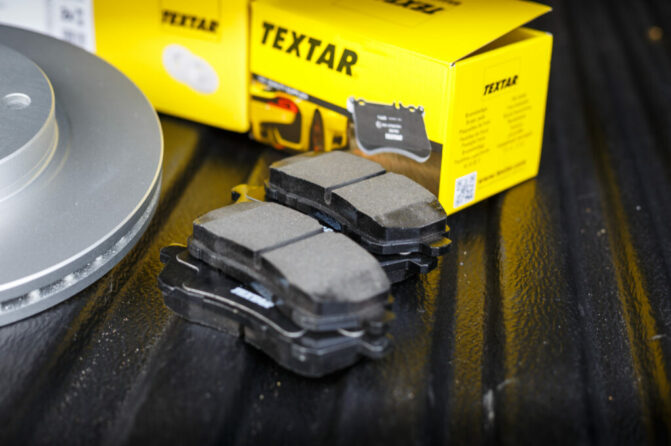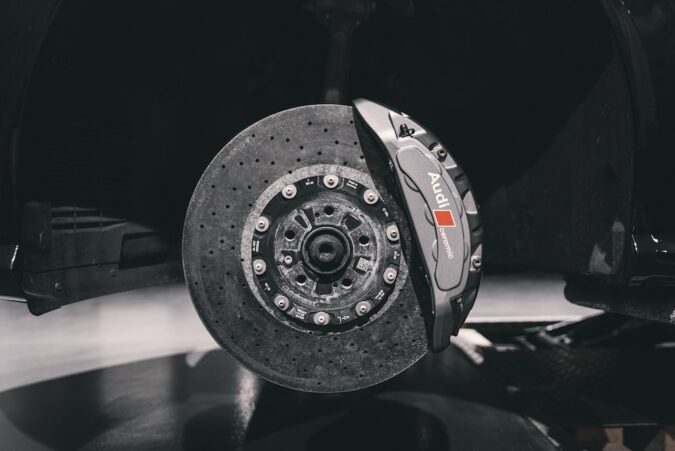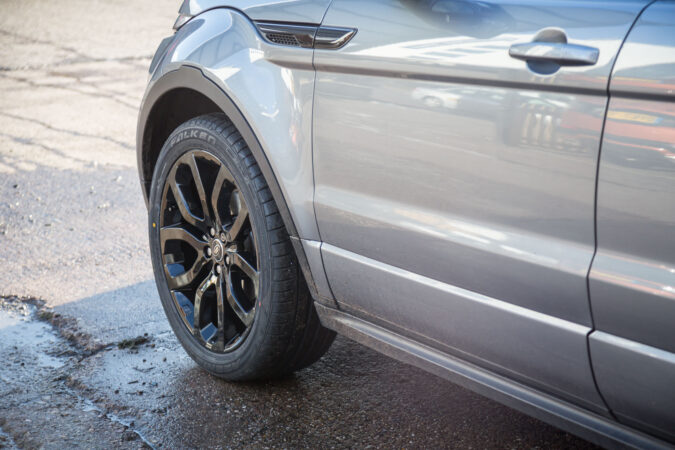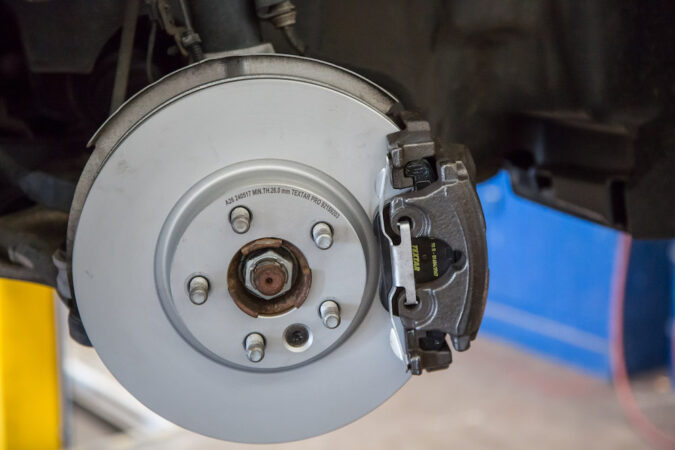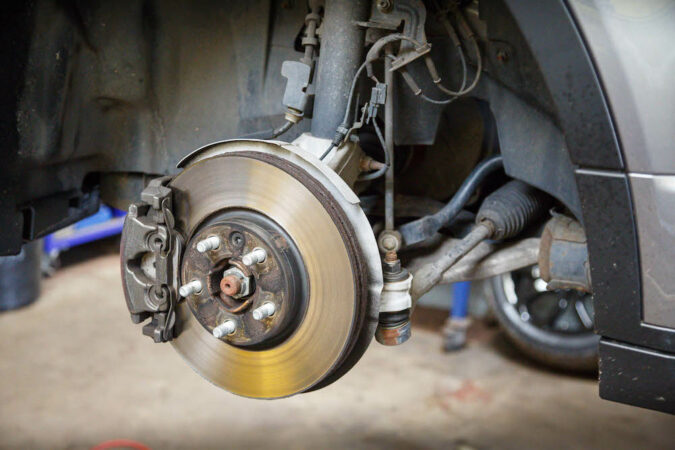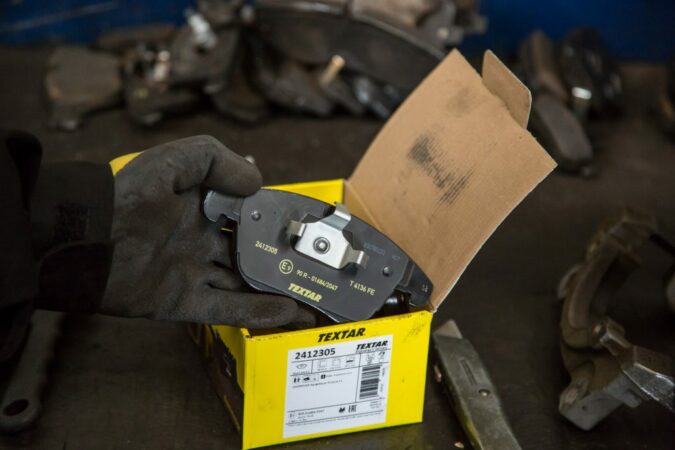Brakes are equally, or even more important in a vehicle. If you scour through any maintenance guides, one of the key areas that they all unanimously agree to spend your money on, are brakes. Brake pads are one of the brake system’s most common replaceable parts. Organic vs ceramic brake pads are an argument that many of us have to answer when it comes to buying new brake pads.
However, how do you choose between organic vs ceramic brake pads? How are they different from one another? We will try to answer all these questions here. As a pre-requisite, it is essential to learn the working of organic vs ceramic brake pads.
In the coming sections, we will deal with their construction, performance, cost, and replacement intervals. Armed with all this info, making an informed choice between organic vs ceramic brake pads during your next purchase is going to be a cakewalk for you.
If organic vs ceramic brake pads comparison does not provide a good result for you, fret not. We will also give other kinds of brake pads a glance to ensure that you find the right brake pad for your application.
Before we look into the details of each type of brake pad, we will familiarize ourselves with the working of a brake pad.
- Working Of Brake Pads
- Construction Of Brake Pads
- Organic Vs Ceramic Brake Pads
- Cost
- Other Types Of Brake Pads
How Does A Brake Pad Work?
Everybody knows that modern braking systems use high friction surfaces to stop the vehicle. In a disc brake system, the brake pads grab the disc or rotor from both sides, bringing down the rotation of the wheel.
The braking starts when the driver presses down on the brake pedal. A brake booster that sits ahead of the firewall amplifies the pressure exerted on the pedal. The brake booster uses a vacuum from the engine to increase the pressure. To learn more about the functioning of a brake booster and the symptoms of a bad example, here is a story for you.
The brake booster transfers this boosted braking pressure to a master cylinder. This is a brake fluid reservoir that distributes brake fluid to the brakes on each wheel, depending on a myriad of factors. It calculates the pressure needed at individual wheels by considering inputs from the wheel speed sensor, the ESP, and more.
When the pressurized brake fluid reaches the calipers on individual wheels, they use it to mobilize the brake pads. The brake pads then exert pressure on the rotor, bringing its rotation down. As the rotor connects directly to the wheel, when it stops, the wheel stops.
The importance of a brake pad in a braking system is way too high to ignore. This is the very reason we do not take the purchase of new brake pads lightly. Hence, proving the importance of organic vs ceramic brake pads discussion. With no further ado, let us hop in and understand how they differ from one another in operation, cost, longevity, and more.
Organic Vs Ceramic Brake Pads: How Do Their Construction Differ From Each Other?
When we pit organic vs ceramic brake pads, the first thing we should consider is the construction of these brake pads. As their names clearly suggest, organic vs ceramic brake pads differ the greatest in the materials that are used to build them. This difference in materials also gives them completely different characters.
This difference is evident in the way they respond to braking, the feedback they give to the driver, the amount of bite they can produce, the quantity of dust they emanate, their longevity, and a lot more. First, let us look at how organic brake pads are made, and understand in detail the most commonly used brake pad type.
Construction Of Organic Brake Pads
As its name clearly suggests, organic brake pads utilize organic materials for their construction. They mostly utilize materials like carbon, rubber, Kevlar, and glass as their primary ingredient. A resin agent will also be added to bond the materials together and produce a brake pad.
Asbestos, a substance hated for its carcinogenic properties, was also used as a friction-producing element. It is even legal to use it in small amounts. If you want to buy an organic brake pad without asbestos in it, look for one branded “NAO”, or Non-Asbestos Organic.
But in general, the most common rule to differentiate organic vs ceramic brake pads, or metallic ones for that matter, is the metal content in them. Organic brake pads have less than 30% metal content in their material. If the metallic content goes beyond 30%, it falls into the semi-metallic brake pad category. We will talk about these brake pads later in this story, once we settle the organic vs ceramic brake pads debate.
Circling back to the organic brake pads, it is to be noted that most of the cars you see on the road are equipped with these. These brake pads are inexpensive to make and provide decent performance for a low-performance commute machine.
We will reserve the deeper explanation of the characteristics of organic vs ceramic brake pads for a later section. But, in general, the performance of organic brake pads is sufficient for a regular car. But once the performance of the car increases, the required braking efficiency creeps beyond its performance. This opens room for the organic vs ceramic brake pads debate.
Construction Of Ceramic Brake Pads
The next candidate in the organic vs ceramic brake pads debate sits on the other end of the performance spectrum. The ceramic brake pads differ greatly from the organic brake pads in terms of performance and this is due to the completely different materials they utilize.
As its name gives away, ceramic brake pads use ceramic compounds that are hard-wearing. These materials are combined with bonding agents and resins to produce an actual brake pad. Sometimes, you may also find some copper fibers embedded into them to improve thermal conductivity and friction.
When you discuss the popularity of organic vs ceramic brake pads, you can see that organic brake pads are more widely used. But this may be due to the fact that ceramic brake pads are relatively new to the market. They made their entry during the 1980s. Many drivers are yet to be initiated into the world of these high-performance brake pads.
But compared to the organic vs ceramic brake pads, these ceramic pads have a lot to bring to the table. Despite their lower popularity, their demand has been steadily climbing over the years.
Now, you know how to stack up organic vs ceramic brake pads in terms of the materials. So, how do you compare them in terms of their performance? Let us find out.
Organic Vs Ceramic Brake Pads: Performance Differences
Well, this is the most important bit of information any customer needs to make an informed choice between organic vs ceramic brake pads. Here, we will look at each of the main characteristics of a brake pad and stack up organic vs ceramic brake pads to see which one comes on top.
Here are some main traits a customer like you or me will be interested in a brake pad.
1. Dust
Aaah! Brake dust. Anyone who washes their own car needs no introduction to this absolute menace. It is definitely an ugly sight to see and it is equally frustrating to wash it away as well. If you are a sucker for clean wheels, you may want to stay away from organic brake pads. They produce the most brake dust of all brake pad types.
The organic material used in their construction is a bit more compressible, wearing it out quickly. This produces a lot of brake dust every time you brake. This is what you see sticking to your beautiful wheels. And if you are the sort of person who takes your car to occasional fun track days, you will have to endure this a lot more. Hard braking eats into your organic brake pads more and produces a lot more dust than usual.
If you compare organic vs ceramic brake pads in terms of brake dust, ceramic pads are a huge improvement. These are known to be extraordinarily low-dust. To make matters even sweeter, the little dust that they do produce is easily washable as well. This is down to the fact that ceramic materials and more firm and less compressible.
So, if you love your new neon wheels shining like they always did, organic brake pads may not be your thing. Else, cleaning the dust off your wheels will be your daily fare, and we doubt no one would be happy doing that day in and day out. But if you do choose to do so, here is a product we found on Amazon that can help you.
But brake dust in itself is not a dipstick that can determine an answer to the organic vs ceramic brake pads debate. So let us look at another trait of these brake pads that people are more interested in.
2. Longevity
This is one thing that everyone needs with any wear and tear part of their cars. Brake pads are consumed every time you brake. There is no running away from this fact as the friction eating up your brake pads is the very thing that helps you stop the vehicle safely. The only workaround is to buy a brake pad that lasts longer. So how do organic vs ceramic brake pads compare to one another in terms of longevity?
The answer to this question is right there in the brake dust comparison. The longevity of the brake pad is directly proportional to how compressible the brake pad material is. If the brake pad material is highly compressible like an organic material, it can wear out easily. That is the reason why you have more dust coming from these brake pads. Organic brake pads are known to wear out more.
But in regular day-in-day-out usage, organic brake pads can last a decently long time. Of course, other types of brake pads can last longer in these situations. But it is when you push the vehicle that you eat up your brake pads more. Organic brake pads wear out like crazy when you are braking late and hard. Especially on a track.
Ceramic brake pads come as a solution to this problem, thanks to the less compressible material used in its construction. This allows the ceramic pads to exert the same amount of pressure on the rotor without eating much into its own material. Hence, your brake pads will last longer and have less brake dust every time you brake. A win-win, if you ask me.
3. Stopping Power
Why do we use brakes? To stop our vehicles, is it not? So, the best metric to compare two brake pads is, of course, their braking performance. When you pit organic vs ceramic brake pads in terms of braking performance, it might seem to you that you have a clear winner on paper. But on paper, it is a different story compared to real life.
Organic brake pads are the most used brake pads in the automotive world. This immense popularity does stem from a lot of merits. Though the braking performance of an organic brake pad is less than that of a ceramic brake pad, it is good enough for most drivers and cars.
For a low-powered commuter car, massive braking performance is not necessary. It seldom attains colossal speeds, sometimes not even once in its entire lifetime. Most of the drives are confined within the limits of a city. Taking this into consideration, the added braking performance offered by a ceramic brake pad may not justify the cost.
But that does not mean that ceramic brake pads are too expensive for what it offers. These pads’ braking performance is far superior to that of the organic brake pads. Even in normal driving conditions, this superiority can be easily noticed. But this becomes extremely obvious when the vehicle is pushed to its limits. For instance, on a track, the better bite of the ceramic pads can mean later braking and faster lap times.
4. Brake Fade
The fact that organic vs ceramic brake pads also differ in terms of heat performance helps in this situation. Organic brake pads can develop brake fade after a hard operation. If they are pushed to their limits, the friction can heat them up beyond their working window, and their ability to brake the car fades.
If you push these brake pads too much beyond their thermal envelope, they can fall apart, eventually. This is not ideal if you are planning to drive your car really hard on a track. In such situations where consistent braking performance throughout the drive is paramount, organic pads fall behind the expectations.
In contrast, the thermal performance of the ceramic brake pads surpasses that of the organic pads. Their working window is larger than that of organic brake pads, and they do not give up that easily even at higher temperatures. This comes as an advantage in situations where organic brake pads usually do not work.
You will still have tremendous bite from the brakes even after pushing them to their absolute limit. This is one of the most noted differences when we compare organic vs ceramic brake pads.
5. Braking Noise
When we compare organic vs ceramic brake pads, you always have a clear winner when we consider most traits. But if there is one trait where they are almost equal in terms of performance, it is the braking noise. Organic vs ceramic brake pads do not offer a clear contrast in terms of the noise they produce. Both types of brake pads produce minimal noise, even under hard braking.
This is not a direct measure of the braking performance of organic vs ceramic brake pads. But it is worth considering, as a squealing brake can be more than just a nuisance for many. Though there is not much difference, the ceramic brake pads produce less noise than organic pads. The organic brake pads do not make much noise in the first place. The ceramic brake pads can improve it even further.
6. Effect On Rotors
This is yet another trait where a clear winner is not available. But unlike brake noise, we cannot see some difference in behavior when we compare organic vs ceramic brake pads based on this aspect. Both organic and ceramic brake pads go easy on the brake rotors, extending their life.
Replacing a brake rotor is an expensive business, and you certainly do not want brake pads to eat into it. So, if you go with either of these types, your brake rotor will thank you.
If you are worried about brake noise or the life of your brake rotor, there is one kind of brake pad you should stay away from. We will discuss them in the coming sections.
Cost Of Organic Vs Ceramic Brake Pads
After all, cash is king. No matter the capabilities of a brake pad type, its cost matters the most to most customers. In the organic vs ceramic brake pads, here is where the organic brake pads claw some lead back. As it uses inexpensive materials to make, it is cheaper than other brake pad types.
Ceramic brake pads are more expensive than organic brake pads, owing to the costlier materials used to make them. Hence, most customers who do not need an exceedingly good performance from their brakes use organic brake pads. They do not spend extra on ceramic brake pads as the situations they drive-in is not demanding enough. They may not get enough avenues to enjoy the capabilities of a ceramic brake pad.
That is why most small car users prefer organic brake pads. And rightly so. But if you use a heavier vehicle, or you indulge in some spirited driving every now and then, you can spend on ceramic brake pads.
Other Type Of Brake Pads
If the organic vs ceramic brake pads discussion does not excite you at all, what are the other choices? There are a couple of other brake pads to choose from but it depends on your application. Let us see these types in detail and list out their pros and cons.
Semi-Metallic Brake Pads
If the metallic content in the brake pad is more than 30%, it is classified as a semi-metallic brake pad. They usually use compounds with iron, steel, copper, or graphite, all bound together with some kind of resin.
The advantages semi-metallic pads bring into this fight start with very good stopping power. The braking performance of these brake pads is superior to that of ceramic brake pads. The firmer material also gives the driver better feedback from the brakes. This is especially important on a track, or any other performance driving setting. The thermal performance of metallic pads is also impressive with really good braking performance even at higher temperatures.
But there are disadvantages as well. The brake dust from these pads is higher than that of ceramic pads but lower than organic pads. The firmer material also makes the life of a brake rotor harder. These brake pads press on the rotor more aggressively, and the abrasive action is stronger. This can reduce the life of the brake rotor considerably. Oh, also, it squeaks a lot. This unique combination of advantages and disadvantages makes it suitable mostly for competitive driving or heavy trucks.
Hybrid Organic Brake Pads
If you want to go one up on the organic brake pads but do not want to spend on a ceramic pad, this may be the one for you. They are technically organic brake pads with less than 30% metallic content but with additional friction modifiers. They help blur the line between organic vs ceramic brake pads.
This kind of brake pad does offer a decent increase in performance over organic brake pads. But they cannot match the ceramic brake pads as well. Even in terms of cost, they lie just above the organic brake pads. You get a brake pad with more braking power, lesser dust but similar low braking noise, and longevity for a marginal increase in cost.
Brake Pads Facts:
- The braking system in a vehicle is critical for safety.
- Brake pads come in three types: ceramic, semi-metallic, and organic.
- Organic brake pads are made of fibers and materials, producing less dust than metallic pads.
- Ceramic brake pads are more durable than organic pads, but they are the most expensive.
- Metallic brake pads are preferred by performance-driven drivers because they offer improved braking performance in a much broader range of temperatures and conditions.
- Organic brake pads wear out faster and require more force to engage than metallic or ceramic brake pads.
- Ceramic brake pads have copper fibers embedded within them, making them denser and more durable.
- Metallic brake pads tend to produce more brake dust and can be noisier than ceramic or organic pads.
- The type of brake pad chosen depends on vehicle manufacturer recommendations, driving style, and expected ride.
- Regular brake pad inspections and replacements are crucial for vehicle safety.
Conclusion: Organic Vs Ceramic Brake Pads, Which Is Better?
If pure performance is considered, there is only one winner. The ceramic brake pads blow the organic pads out of the water in terms of performance. But the organic vs ceramic brake pads debate cannot be settled with just that.
The cost enters the picture giving us a clear answer to this question. If you have a commuter car that you drive inside the city, shelling your bucks on ceramic pads is unnecessary. But if you mind spending your money on some additional braking performance, by all means, go ahead.
Using organic pads on a high-powered vehicle is not a good idea either. In these situations, the additional braking power of ceramic pads can be a lifesaver.

